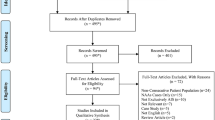Abstract
Study design
Retrospective cohort study
Objectives
To determine prevalence of hereditary multiple osteochondromas (HMO) and utility of MRI surveillance in a prospective Spine at Risk (SAR) program.
Summary of background data
Unidentified intraspinal exostoses in HMO can lead to neurologic injury in children during sedated procedures but no MRI guidelines exist. We sought to determine the prevalence and age of intraspinal exostoses from MRIs, and indications for MRI surveillance.
Methods
Retrospective review was performed of pediatric HMO patients who underwent total spine MRIs at a single institution after a prospective SAR program was instituted. Charts were reviewed for MRI indication and findings, symptoms, surgery, and location of other exostoses. Fisher’s exact test was used to compare categorical variables and T test to compare continuous variables. Predictive value of pelvic/rib exostoses was calculated for intraspinal lesions.
Results
Forty-three patients with HMO underwent total spine MRIs with average age of 11.5 years. Fifteen (35%) patients had exostoses on vertebral column, eight (19%) had intra-canal spinal exostoses. Higher prevalence of spine lesions occurred in symptomatic patients than asymptomatic (any spinal lesion: 73% prevalence in symptomatic vs 22% in asymptomatic, p < 0.005; intra-canal spinal lesion: 46% vs 9%, p < 0.05). Only two of the 11 ‘symptomatic presentations’ could be attributable to intracanal spinal exostoses. Only one intra-canal exostosis found on asymptomatic surveillance was treated surgically. Presence of pelvic or rib exostoses were not strongly predictive of intra-canal lesions (23% PPV, 85% NPV, 63% sensitivity, 51% specificity).
Conclusions
Even with the presence of intra-canal exostoses, true symptomatic lesions are rare. Rib and pelvic lesions were not predictive of intra-canal lesions in our population. We recommend obtaining MRIs at time of preoperative evaluation in asymptomatic children old enough to not need sedation, or in patients with true neurologic symptoms to prevent unnecessary sedation of younger children for surveillance MRI.
Level of evidence
III.




Similar content being viewed by others
References
Schmale GA, Conrad EU 3rd, Raskind WH (1994) The natural history of hereditary multiple exostoses. J Bone Jt Surg Am 76(7):986–992
Roach JW (2010) Hereditary multiple exostoses with spine involvement in a 4-year-old boy. Am J Med Genet Part A 152A(5):1263–1263
Singh KA, Shankar V, Mohanty SP (2016) Unusual case of hereditary multiple exostoses presenting with compressive myelopathy. BMJ Case Rep 2016:10–12
Bess RS, Robbin MR, Bohlman HH et al (2005) Spinal exostoses analysis of twelve cases and review of the literature. Spine (Phila Pha 1976) 30(7):774–780
Roach JW, Klatt JWB, Faulkner ND (2009) Involvement of the spine in patients with multiple hereditary exostoses. J Bone Jt Surg Ser A 91(8):1942–1948
Ashraf A, Larson AN, Ferski G et al (2013) Spinal stenosis frequent in children with multiple hereditary exostoses. J Child Orthop 7(3):183–194
Barton K, Nickerson JP, Higgins T et al (2018) Pediatric anesthesia and neurotoxicity: what the radiologist needs to know. Pediatr Radiol 48(1):31–36
Jackson TJ, Shah AS, Arkader A (2019) Is routine spine MRI necessary in skeletally immature patients with MHE? Identifying patients at risk for spinal osteochondromas. J Pediatr Orthop 39(2):E147–E152
Carmel PW, Cramer FJ (1968) Cervical cord compression due to exostosis in a patient with hereditary multiple exostoses case report. J Neurusurg 28:500–503
Sharma MC, Arora R, Deol PS et al (2002) Osteochondroma of the spine: an enigmatic tumor of the spinal cord. A series of 10 cases. J Neurosurg Sci 46(2):66–67 (discussion 70)
Yukawa Y, Kato F, Sugiura H (2001) Solitary osteochondroma of the lower cervical spine. Orthopedics 24(3):292–293
Moon K-S, Lee J-K, Kim Y-S et al (2006) Case report osteochondroma of the cervical spine extending multiple segments with cord compression. Pediatr Neurosurg 42:304–307
Shapiro SA, Javid T, Putty T (1990) Osteochondroma with cervical cord compression in hereditary multiple exostoses. Spine (Phila Pha 1976) 15(6):600–601
Moriwaka F, Hozen H, Nakane K et al (1990) Myelopathy due to osteochondroma. J Comput Assist Tomogr 14(1):128–130
Thompson RL, Hosseinzadeh P, Muchow RD et al (2014) Syringomyelia and vertebral osteochondromas in patients with multiple hereditary exostosis. J Pediatr Orthop Part B 23(5):449–453
Giudicissi-Filho M, de Holanda CVM, Borba LAB et al (2006) Cervical spinal cord compression due to an osteochondroma in hereditary multiple exostosis: case report and review of the literature. Surg Neurol. 66(SUPPL. 3):S7–S11
Kamiya Y, Horii E, Sakai Y et al (2016) Cervical cord compression in pediatrics with hereditary multiple exostoses: a report of two cases and review of the literature. J Pediatr Orthop Part B 25(3):267–270
Funding
We have no funding to disclose. Institutional Review Board (IRB) approval obtained prior to data collection with consent exemption.
Author information
Authors and Affiliations
Corresponding author
Additional information
Publisher's Note
Springer Nature remains neutral with regard to jurisdictional claims in published maps and institutional affiliations.
Rights and permissions
About this article
Cite this article
Vu, C.L., Lindberg, A.W., Bompadre, V. et al. Prospective spine at risk program for prevalence of intracanal spine lesions in pediatric hereditary multiple osteochondromas. Spine Deform 8, 1069–1074 (2020). https://doi.org/10.1007/s43390-020-00130-4
Received:
Accepted:
Published:
Issue Date:
DOI: https://doi.org/10.1007/s43390-020-00130-4




